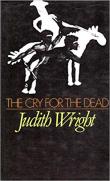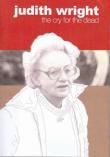AustLit
Latest Issues
AbstractHistoryArchive Description
'Judith Wright was an Australia national treasure, In the Cry for the dead, she creates a harrowing evocation of the difficulties faced by the early settlers and the suffering of Australia's Indigenous people.' (Publication summary)
Publication Details of Only Known VersionEarliest 2 Known Versions of
Other Formats
- Also braille and sound recording.
Works about this Work
-
The Cry for the Dead : Judith Wright
2016
single work
criticism
— Appears in: The Art of Time Travel : Historians and Their Craft 2016; (p. 94-113) -
On the Frontier : The Intriguing Dance of History and Fiction
2015
single work
criticism
— Appears in: The Conversation , 10 June 2015; Writing History 2015; 'This article is the second in a series examining the links, problems and dynamics of writing, recording and recreating history, whether in fiction or non-fiction.' -
The Intriguing Dance of History and Fiction
2015
single work
criticism
— Appears in: TEXT Special Issue Website Series , April no. 28 2015; 'In this essay I explore the common ground of history and fiction, suggesting that they are a tag team, sometimes taking turns, sometimes working in tandem, to deepen our understanding and extend our imagination. But I also argue that there are times when the distinction between them is vital, and that it is incumbent on historians – on those who choose at certain moments to write history – to insist and reflect on the difference. I hope to create a context in which such explanations will not be misinterpreted as defending territory. In the course of the essay I refer to historians who write fiction and novelists who write history, and I draw especially on the work of the novelists Eleanor Dark and Kate Grenville, poet and historian Judith Wright, and the historians Inga Clendinnen, Grace Karskens and Ross Gibson.' (Publication summary) -
Australian Poetry : Reflections on Nature, Space and Identity
2010
single work
criticism
— Appears in: Explorations In Australian Poetry 2010; (p. 1-40) Jayne Fenton Keane's essay presents an overview of the many treatments of nature rendered by a host of contemporary Australian poets. (v)
-
Judith Wright : The Basis of Our Nation?
2010
single work
criticism
— Appears in: The Well in the Shadow : A Writer's Journey through Australian Literature 2010; (p. 44-59)
-
[Review] The Cry for the Dead
2005
single work
review
— Appears in: API Review of Books , November no. 39 2005;
— Review of The Cry for the Dead 1981 single work prose -
The Cry for the Dead : Book Review
1983
single work
review
— Appears in: Aboriginal History , vol. 7 no. 1-2 1983; (p. 211-213)
— Review of The Cry for the Dead 1981 single work prose -
Truth and Fiction: Judith Wright as Historian
2006
single work
criticism
— Appears in: Australian Book Review , August no. 283 2006; (p. 25-30) Griffiths argues that 'one way that Wright came to reconcile [her two passions of art and activism] was to choose a different kind of art - that of history. Poetry and politics came together to produce disciplined non-fiction.' -
y
 With Love and Fury : Selected Letters of Judith Wright
Patricia Clarke
(editor),
Meredith McKinney
(editor),
Canberra
:
National Library of Australia
,
2006
Z1331209
2006
selected work
correspondence
Judith Wright, the great Australian poet, writer, environmentalist and activist for Aboriginal rights, was a prolific letter writer throughout her long life. Judith's first surviving letter, written as a girl of 10, is already vibrant with both the pleasure in language and the intense responsiveness to the natural world that formed the core of her being and dictated the directions of her life. The collection of letters presented in With Love and Fury serves to remind us of Judith's deep engagement with life, and of her love of the world (and of friends) and the fine fury that lead her to battle so courageously on the world's behalf - those sides of the single passion that shaped both her poetry and her life. (Publisher's website)
With Love and Fury : Selected Letters of Judith Wright
Patricia Clarke
(editor),
Meredith McKinney
(editor),
Canberra
:
National Library of Australia
,
2006
Z1331209
2006
selected work
correspondence
Judith Wright, the great Australian poet, writer, environmentalist and activist for Aboriginal rights, was a prolific letter writer throughout her long life. Judith's first surviving letter, written as a girl of 10, is already vibrant with both the pleasure in language and the intense responsiveness to the natural world that formed the core of her being and dictated the directions of her life. The collection of letters presented in With Love and Fury serves to remind us of Judith's deep engagement with life, and of her love of the world (and of friends) and the fine fury that lead her to battle so courageously on the world's behalf - those sides of the single passion that shaped both her poetry and her life. (Publisher's website)
-
Wilderness and Garden
1984
single work
criticism
— Appears in: A Sense of Place : Essays in Post-Colonial Literatures 1984; (p. 19-24) Stow comments on the writing of William Charles Wentworth and the paintings of John Glover to suggest that they were, 'in their relation to the land, closer to the Aborigines than any of their vandalizing descendants' (24). -
Ancestral Echoes : Spectres of the Past in Judith Wright's Poetry
2007
single work
criticism
— Appears in: JASAL , Special Issue 2007; (p. 117-129)Sue King-Smith says: 'There are three main spectres in Wright's poetry that this article addresses. The first relates to the loss and separation Wright experienced when she became aware of the history of the land she had felt a profound sense of identification with since early childhood ... The second spectre relates to the traces of Aboriginal massacres and dispossessions. And the third is the spectre of the indigenous landscape that existed prior to British occupation, with a substantial number of indigenous species of flora and fauna now extinct.
'This article will argue that these spectres are intimately linked in Wright's writing and that her poetic and private relationships with the Australian landscape are constantly mediated by the need to acknowledge these ghosts.' (pp.117-118)
-
Expulsion, Exodus and Exile in White Australian Historical Mythology
1999
single work
criticism
— Appears in: Journal of Australian Studies , no. 61 1999; (p. 1-18) Ann Curthoys examines 'how notions of exile and exodus permeate some key figures in Australian history, the convicts and pioneers' (3). She draws on historical works as well as fiction and film. In the second half of her essay she argues that the Mabo decision has reawakened non-Indigenous Australian's fear of homelessness.




